Asthma Case Study: Pathogenesis, Patient Positioning, and Medications
VerifiedAdded on 2022/12/05
|7
|1788
|262
Case Study
AI Summary
This case study presents a detailed analysis of a patient, Peter, suffering from acute asthma. It begins by exploring the pathogenesis of asthma, discussing host and environmental factors that contribute to the condition, including genetic predispositions, immune responses, allergens, and respiratory infections. The case study then addresses patient management, focusing on proper patient positioning using Fowler’s position, and oxygen therapy. The core of the case study examines the use of Salbutamol, Hydrocortisone, and Ipratropium Bromide. For each medication, the study covers the mechanism of action, the rationale for its use in relation to the patient's symptoms, nursing considerations, and expected clinical responses. The study also highlights the importance of continuous clinical observations. References to relevant research papers are included to support the analysis. This assignment provides insights into the comprehensive care of asthma patients, offering valuable knowledge for healthcare students and professionals.

Asthma Case Study
Paraphrase This Document
Need a fresh take? Get an instant paraphrase of this document with our AI Paraphraser
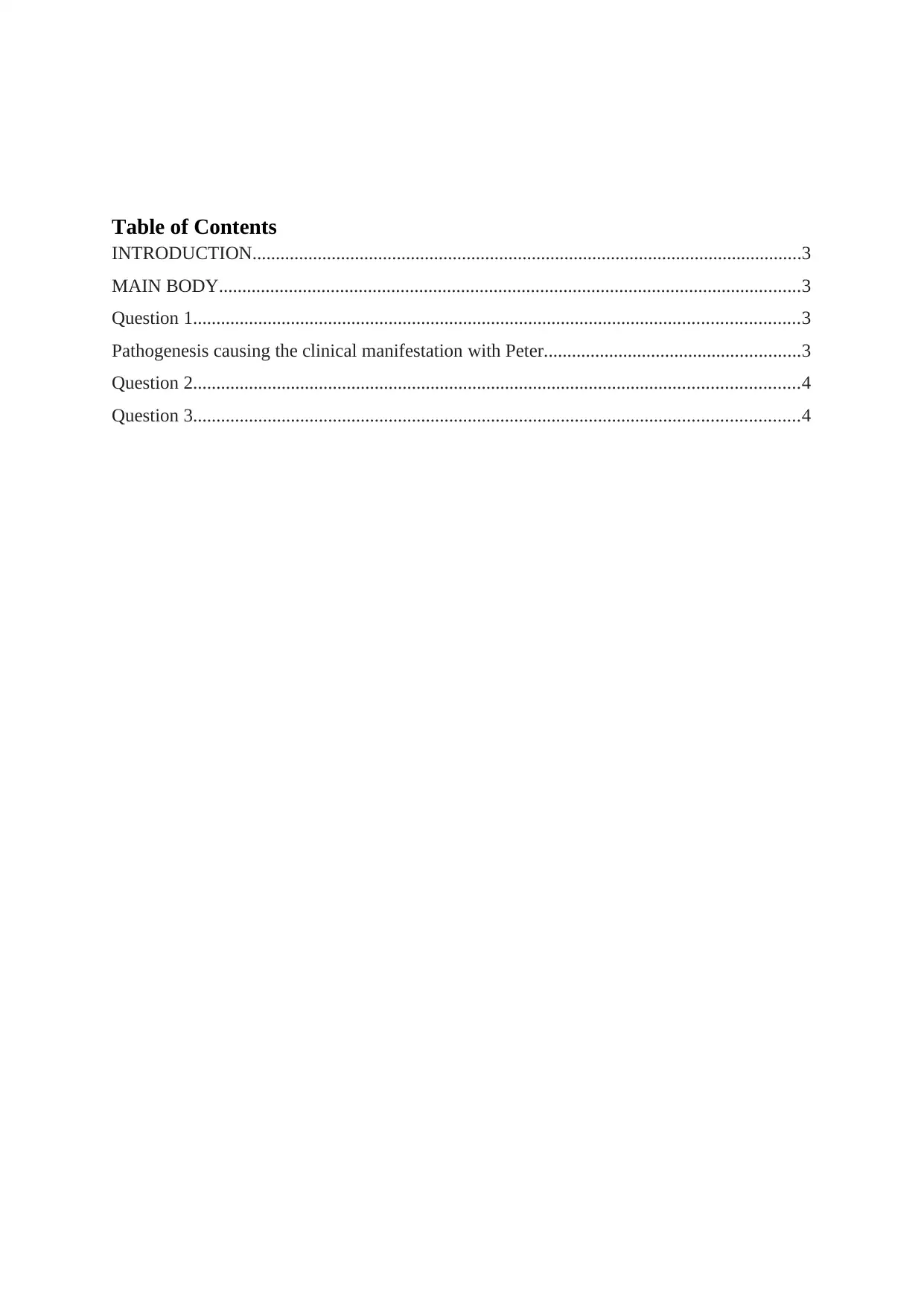
Table of Contents
INTRODUCTION......................................................................................................................3
MAIN BODY.............................................................................................................................3
Question 1..................................................................................................................................3
Pathogenesis causing the clinical manifestation with Peter.......................................................3
Question 2..................................................................................................................................4
Question 3..................................................................................................................................4
INTRODUCTION......................................................................................................................3
MAIN BODY.............................................................................................................................3
Question 1..................................................................................................................................3
Pathogenesis causing the clinical manifestation with Peter.......................................................3
Question 2..................................................................................................................................4
Question 3..................................................................................................................................4
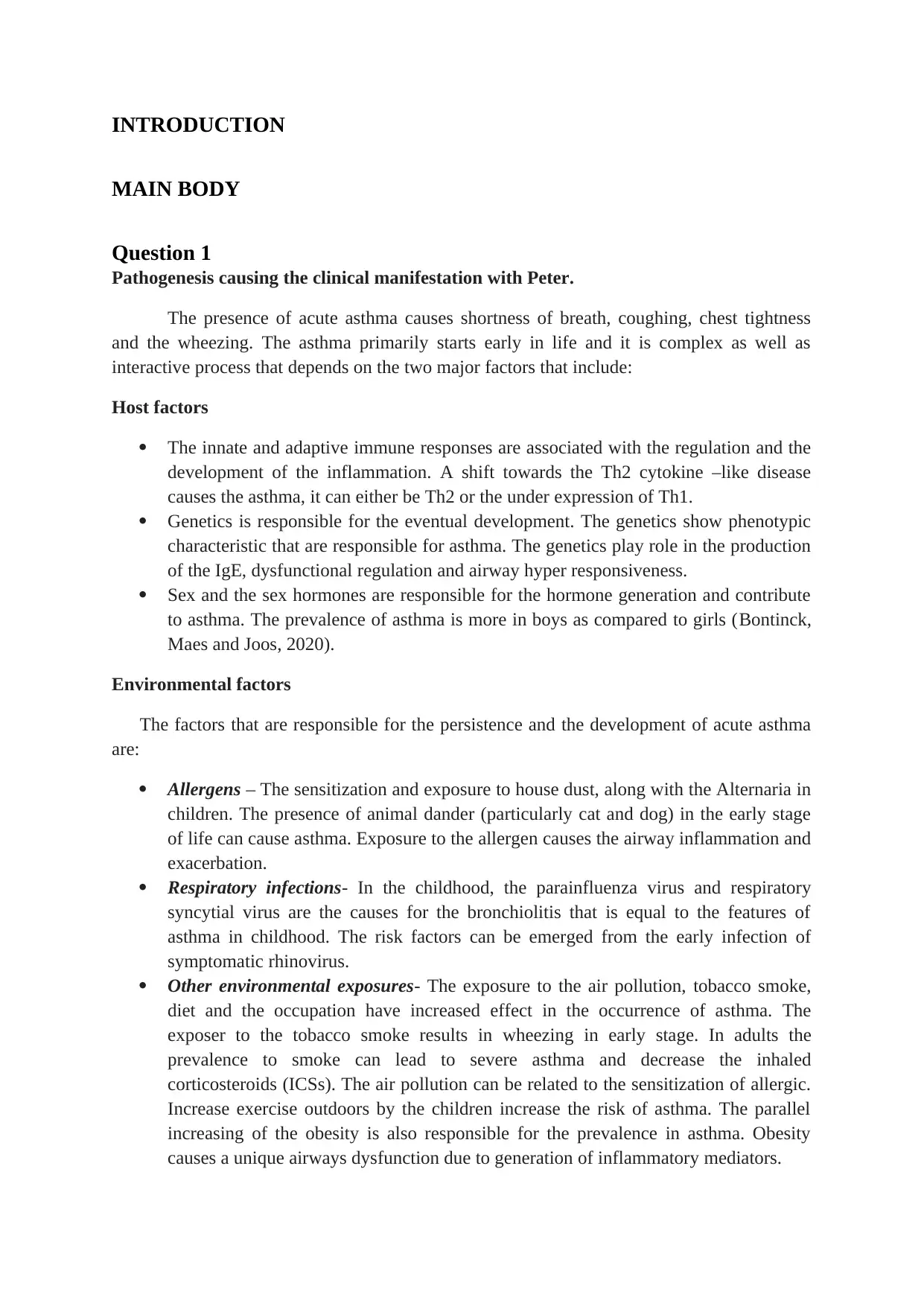
INTRODUCTION
MAIN BODY
Question 1
Pathogenesis causing the clinical manifestation with Peter.
The presence of acute asthma causes shortness of breath, coughing, chest tightness
and the wheezing. The asthma primarily starts early in life and it is complex as well as
interactive process that depends on the two major factors that include:
Host factors
The innate and adaptive immune responses are associated with the regulation and the
development of the inflammation. A shift towards the Th2 cytokine –like disease
causes the asthma, it can either be Th2 or the under expression of Th1.
Genetics is responsible for the eventual development. The genetics show phenotypic
characteristic that are responsible for asthma. The genetics play role in the production
of the IgE, dysfunctional regulation and airway hyper responsiveness.
Sex and the sex hormones are responsible for the hormone generation and contribute
to asthma. The prevalence of asthma is more in boys as compared to girls (Bontinck,
Maes and Joos, 2020).
Environmental factors
The factors that are responsible for the persistence and the development of acute asthma
are:
Allergens – The sensitization and exposure to house dust, along with the Alternaria in
children. The presence of animal dander (particularly cat and dog) in the early stage
of life can cause asthma. Exposure to the allergen causes the airway inflammation and
exacerbation.
Respiratory infections- In the childhood, the parainfluenza virus and respiratory
syncytial virus are the causes for the bronchiolitis that is equal to the features of
asthma in childhood. The risk factors can be emerged from the early infection of
symptomatic rhinovirus.
Other environmental exposures- The exposure to the air pollution, tobacco smoke,
diet and the occupation have increased effect in the occurrence of asthma. The
exposer to the tobacco smoke results in wheezing in early stage. In adults the
prevalence to smoke can lead to severe asthma and decrease the inhaled
corticosteroids (ICSs). The air pollution can be related to the sensitization of allergic.
Increase exercise outdoors by the children increase the risk of asthma. The parallel
increasing of the obesity is also responsible for the prevalence in asthma. Obesity
causes a unique airways dysfunction due to generation of inflammatory mediators.
MAIN BODY
Question 1
Pathogenesis causing the clinical manifestation with Peter.
The presence of acute asthma causes shortness of breath, coughing, chest tightness
and the wheezing. The asthma primarily starts early in life and it is complex as well as
interactive process that depends on the two major factors that include:
Host factors
The innate and adaptive immune responses are associated with the regulation and the
development of the inflammation. A shift towards the Th2 cytokine –like disease
causes the asthma, it can either be Th2 or the under expression of Th1.
Genetics is responsible for the eventual development. The genetics show phenotypic
characteristic that are responsible for asthma. The genetics play role in the production
of the IgE, dysfunctional regulation and airway hyper responsiveness.
Sex and the sex hormones are responsible for the hormone generation and contribute
to asthma. The prevalence of asthma is more in boys as compared to girls (Bontinck,
Maes and Joos, 2020).
Environmental factors
The factors that are responsible for the persistence and the development of acute asthma
are:
Allergens – The sensitization and exposure to house dust, along with the Alternaria in
children. The presence of animal dander (particularly cat and dog) in the early stage
of life can cause asthma. Exposure to the allergen causes the airway inflammation and
exacerbation.
Respiratory infections- In the childhood, the parainfluenza virus and respiratory
syncytial virus are the causes for the bronchiolitis that is equal to the features of
asthma in childhood. The risk factors can be emerged from the early infection of
symptomatic rhinovirus.
Other environmental exposures- The exposure to the air pollution, tobacco smoke,
diet and the occupation have increased effect in the occurrence of asthma. The
exposer to the tobacco smoke results in wheezing in early stage. In adults the
prevalence to smoke can lead to severe asthma and decrease the inhaled
corticosteroids (ICSs). The air pollution can be related to the sensitization of allergic.
Increase exercise outdoors by the children increase the risk of asthma. The parallel
increasing of the obesity is also responsible for the prevalence in asthma. Obesity
causes a unique airways dysfunction due to generation of inflammatory mediators.
⊘ This is a preview!⊘
Do you want full access?
Subscribe today to unlock all pages.

Trusted by 1+ million students worldwide
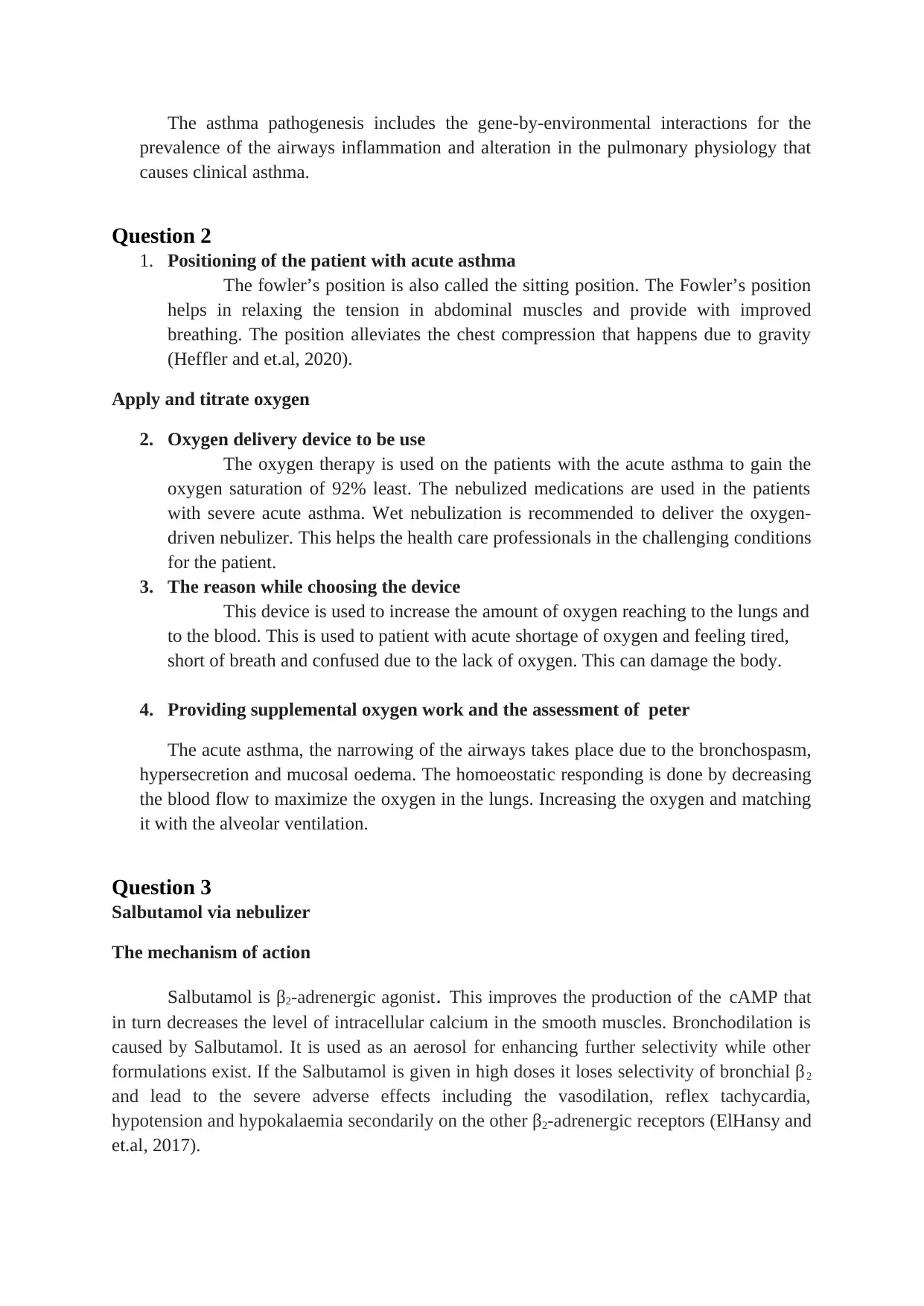
The asthma pathogenesis includes the gene-by-environmental interactions for the
prevalence of the airways inflammation and alteration in the pulmonary physiology that
causes clinical asthma.
Question 2
1. Positioning of the patient with acute asthma
The fowler’s position is also called the sitting position. The Fowler’s position
helps in relaxing the tension in abdominal muscles and provide with improved
breathing. The position alleviates the chest compression that happens due to gravity
(Heffler and et.al, 2020).
Apply and titrate oxygen
2. Oxygen delivery device to be use
The oxygen therapy is used on the patients with the acute asthma to gain the
oxygen saturation of 92% least. The nebulized medications are used in the patients
with severe acute asthma. Wet nebulization is recommended to deliver the oxygen-
driven nebulizer. This helps the health care professionals in the challenging conditions
for the patient.
3. The reason while choosing the device
This device is used to increase the amount of oxygen reaching to the lungs and
to the blood. This is used to patient with acute shortage of oxygen and feeling tired,
short of breath and confused due to the lack of oxygen. This can damage the body.
4. Providing supplemental oxygen work and the assessment of peter
The acute asthma, the narrowing of the airways takes place due to the bronchospasm,
hypersecretion and mucosal oedema. The homoeostatic responding is done by decreasing
the blood flow to maximize the oxygen in the lungs. Increasing the oxygen and matching
it with the alveolar ventilation.
Question 3
Salbutamol via nebulizer
The mechanism of action
Salbutamol is β2-adrenergic agonist. This improves the production of the cAMP that
in turn decreases the level of intracellular calcium in the smooth muscles. Bronchodilation is
caused by Salbutamol. It is used as an aerosol for enhancing further selectivity while other
formulations exist. If the Salbutamol is given in high doses it loses selectivity of bronchial β2
and lead to the severe adverse effects including the vasodilation, reflex tachycardia,
hypotension and hypokalaemia secondarily on the other β2-adrenergic receptors (ElHansy and
et.al, 2017).
prevalence of the airways inflammation and alteration in the pulmonary physiology that
causes clinical asthma.
Question 2
1. Positioning of the patient with acute asthma
The fowler’s position is also called the sitting position. The Fowler’s position
helps in relaxing the tension in abdominal muscles and provide with improved
breathing. The position alleviates the chest compression that happens due to gravity
(Heffler and et.al, 2020).
Apply and titrate oxygen
2. Oxygen delivery device to be use
The oxygen therapy is used on the patients with the acute asthma to gain the
oxygen saturation of 92% least. The nebulized medications are used in the patients
with severe acute asthma. Wet nebulization is recommended to deliver the oxygen-
driven nebulizer. This helps the health care professionals in the challenging conditions
for the patient.
3. The reason while choosing the device
This device is used to increase the amount of oxygen reaching to the lungs and
to the blood. This is used to patient with acute shortage of oxygen and feeling tired,
short of breath and confused due to the lack of oxygen. This can damage the body.
4. Providing supplemental oxygen work and the assessment of peter
The acute asthma, the narrowing of the airways takes place due to the bronchospasm,
hypersecretion and mucosal oedema. The homoeostatic responding is done by decreasing
the blood flow to maximize the oxygen in the lungs. Increasing the oxygen and matching
it with the alveolar ventilation.
Question 3
Salbutamol via nebulizer
The mechanism of action
Salbutamol is β2-adrenergic agonist. This improves the production of the cAMP that
in turn decreases the level of intracellular calcium in the smooth muscles. Bronchodilation is
caused by Salbutamol. It is used as an aerosol for enhancing further selectivity while other
formulations exist. If the Salbutamol is given in high doses it loses selectivity of bronchial β2
and lead to the severe adverse effects including the vasodilation, reflex tachycardia,
hypotension and hypokalaemia secondarily on the other β2-adrenergic receptors (ElHansy and
et.al, 2017).
Paraphrase This Document
Need a fresh take? Get an instant paraphrase of this document with our AI Paraphraser
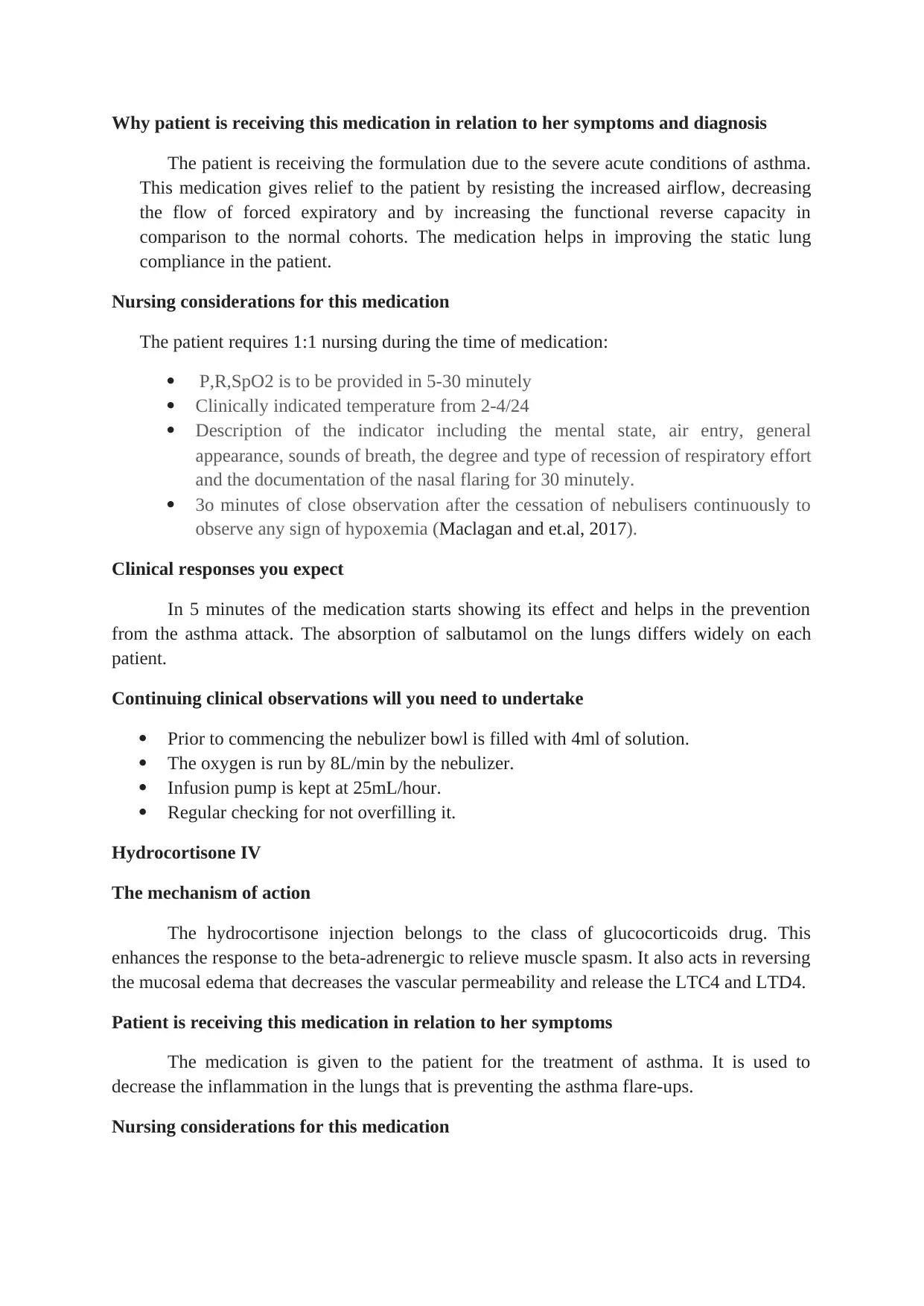
Why patient is receiving this medication in relation to her symptoms and diagnosis
The patient is receiving the formulation due to the severe acute conditions of asthma.
This medication gives relief to the patient by resisting the increased airflow, decreasing
the flow of forced expiratory and by increasing the functional reverse capacity in
comparison to the normal cohorts. The medication helps in improving the static lung
compliance in the patient.
Nursing considerations for this medication
The patient requires 1:1 nursing during the time of medication:
P,R,SpO2 is to be provided in 5-30 minutely
Clinically indicated temperature from 2-4/24
Description of the indicator including the mental state, air entry, general
appearance, sounds of breath, the degree and type of recession of respiratory effort
and the documentation of the nasal flaring for 30 minutely.
3o minutes of close observation after the cessation of nebulisers continuously to
observe any sign of hypoxemia (Maclagan and et.al, 2017).
Clinical responses you expect
In 5 minutes of the medication starts showing its effect and helps in the prevention
from the asthma attack. The absorption of salbutamol on the lungs differs widely on each
patient.
Continuing clinical observations will you need to undertake
Prior to commencing the nebulizer bowl is filled with 4ml of solution.
The oxygen is run by 8L/min by the nebulizer.
Infusion pump is kept at 25mL/hour.
Regular checking for not overfilling it.
Hydrocortisone IV
The mechanism of action
The hydrocortisone injection belongs to the class of glucocorticoids drug. This
enhances the response to the beta-adrenergic to relieve muscle spasm. It also acts in reversing
the mucosal edema that decreases the vascular permeability and release the LTC4 and LTD4.
Patient is receiving this medication in relation to her symptoms
The medication is given to the patient for the treatment of asthma. It is used to
decrease the inflammation in the lungs that is preventing the asthma flare-ups.
Nursing considerations for this medication
The patient is receiving the formulation due to the severe acute conditions of asthma.
This medication gives relief to the patient by resisting the increased airflow, decreasing
the flow of forced expiratory and by increasing the functional reverse capacity in
comparison to the normal cohorts. The medication helps in improving the static lung
compliance in the patient.
Nursing considerations for this medication
The patient requires 1:1 nursing during the time of medication:
P,R,SpO2 is to be provided in 5-30 minutely
Clinically indicated temperature from 2-4/24
Description of the indicator including the mental state, air entry, general
appearance, sounds of breath, the degree and type of recession of respiratory effort
and the documentation of the nasal flaring for 30 minutely.
3o minutes of close observation after the cessation of nebulisers continuously to
observe any sign of hypoxemia (Maclagan and et.al, 2017).
Clinical responses you expect
In 5 minutes of the medication starts showing its effect and helps in the prevention
from the asthma attack. The absorption of salbutamol on the lungs differs widely on each
patient.
Continuing clinical observations will you need to undertake
Prior to commencing the nebulizer bowl is filled with 4ml of solution.
The oxygen is run by 8L/min by the nebulizer.
Infusion pump is kept at 25mL/hour.
Regular checking for not overfilling it.
Hydrocortisone IV
The mechanism of action
The hydrocortisone injection belongs to the class of glucocorticoids drug. This
enhances the response to the beta-adrenergic to relieve muscle spasm. It also acts in reversing
the mucosal edema that decreases the vascular permeability and release the LTC4 and LTD4.
Patient is receiving this medication in relation to her symptoms
The medication is given to the patient for the treatment of asthma. It is used to
decrease the inflammation in the lungs that is preventing the asthma flare-ups.
Nursing considerations for this medication
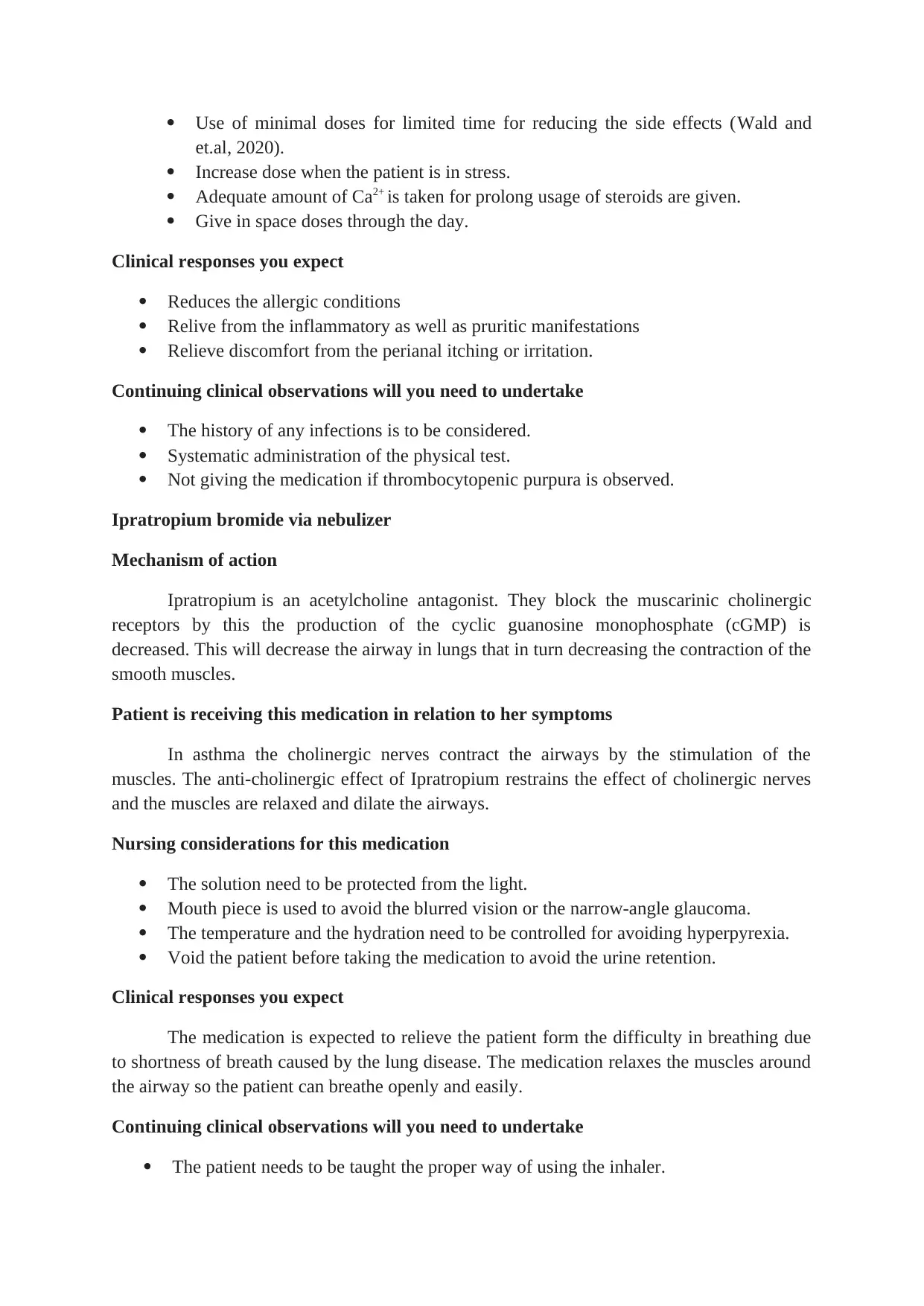
Use of minimal doses for limited time for reducing the side effects (Wald and
et.al, 2020).
Increase dose when the patient is in stress.
Adequate amount of Ca2+ is taken for prolong usage of steroids are given.
Give in space doses through the day.
Clinical responses you expect
Reduces the allergic conditions
Relive from the inflammatory as well as pruritic manifestations
Relieve discomfort from the perianal itching or irritation.
Continuing clinical observations will you need to undertake
The history of any infections is to be considered.
Systematic administration of the physical test.
Not giving the medication if thrombocytopenic purpura is observed.
Ipratropium bromide via nebulizer
Mechanism of action
Ipratropium is an acetylcholine antagonist. They block the muscarinic cholinergic
receptors by this the production of the cyclic guanosine monophosphate (cGMP) is
decreased. This will decrease the airway in lungs that in turn decreasing the contraction of the
smooth muscles.
Patient is receiving this medication in relation to her symptoms
In asthma the cholinergic nerves contract the airways by the stimulation of the
muscles. The anti-cholinergic effect of Ipratropium restrains the effect of cholinergic nerves
and the muscles are relaxed and dilate the airways.
Nursing considerations for this medication
The solution need to be protected from the light.
Mouth piece is used to avoid the blurred vision or the narrow-angle glaucoma.
The temperature and the hydration need to be controlled for avoiding hyperpyrexia.
Void the patient before taking the medication to avoid the urine retention.
Clinical responses you expect
The medication is expected to relieve the patient form the difficulty in breathing due
to shortness of breath caused by the lung disease. The medication relaxes the muscles around
the airway so the patient can breathe openly and easily.
Continuing clinical observations will you need to undertake
The patient needs to be taught the proper way of using the inhaler.
et.al, 2020).
Increase dose when the patient is in stress.
Adequate amount of Ca2+ is taken for prolong usage of steroids are given.
Give in space doses through the day.
Clinical responses you expect
Reduces the allergic conditions
Relive from the inflammatory as well as pruritic manifestations
Relieve discomfort from the perianal itching or irritation.
Continuing clinical observations will you need to undertake
The history of any infections is to be considered.
Systematic administration of the physical test.
Not giving the medication if thrombocytopenic purpura is observed.
Ipratropium bromide via nebulizer
Mechanism of action
Ipratropium is an acetylcholine antagonist. They block the muscarinic cholinergic
receptors by this the production of the cyclic guanosine monophosphate (cGMP) is
decreased. This will decrease the airway in lungs that in turn decreasing the contraction of the
smooth muscles.
Patient is receiving this medication in relation to her symptoms
In asthma the cholinergic nerves contract the airways by the stimulation of the
muscles. The anti-cholinergic effect of Ipratropium restrains the effect of cholinergic nerves
and the muscles are relaxed and dilate the airways.
Nursing considerations for this medication
The solution need to be protected from the light.
Mouth piece is used to avoid the blurred vision or the narrow-angle glaucoma.
The temperature and the hydration need to be controlled for avoiding hyperpyrexia.
Void the patient before taking the medication to avoid the urine retention.
Clinical responses you expect
The medication is expected to relieve the patient form the difficulty in breathing due
to shortness of breath caused by the lung disease. The medication relaxes the muscles around
the airway so the patient can breathe openly and easily.
Continuing clinical observations will you need to undertake
The patient needs to be taught the proper way of using the inhaler.
⊘ This is a preview!⊘
Do you want full access?
Subscribe today to unlock all pages.

Trusted by 1+ million students worldwide

The history of the patient related to the bladder neck obstruction, lactation and the
hypersensitivity to atropine and soybeans are to be documented.
The physical examination is documented that include the texture and skin color,
normal urine output (Kokulu and et.al).
CONCLUSION
REFERNCES
Bontinck, Maes and Joos, 2020. Asthma and air pollution: recent insights in pathogenesis and
clinical implications. Current opinion in pulmonary medicine. 26(1). pp.10-19.
ElHansy and et.al, 2017. Inhaled salbutamol dose delivered by jet nebulizer, vibrating mesh
nebulizer and metered dose inhaler with spacer during invasive mechanical
ventilation. Pulmonary pharmacology & therapeutics. 45. pp.159-163.
Heffler and et.al, 2020. Fractional Exhaled Nitric Oxide (FENO) in the management of
asthma: a position paper of the Italian Respiratory Society (SIP/IRS) and Italian
Society of Allergy, Asthma and Clinical Immunology (SIAAIC). Multidisciplinary
respiratory medicine. 15(1).
Kokulu and et.al, 2019. Pharmacologic anisocoria due to nebulized ipratropium bromide: a
diagnostic challenge. The American journal of emergency medicine. 37(6). pp.1217-
e3.
Maclagan and et.al, 2017. Frailty and potentially inappropriate medication use at nursing
home transition. Journal of the American Geriatrics Societ.65(10). pp.2205-2212.
Wald and et.al, 2020. Hydrocortisone–ascorbic acid–thiamine use associated with lower
mortality in pediatric septic shock. American journal of respiratory and critical care
medicine. 201(7). pp.863-867.
hypersensitivity to atropine and soybeans are to be documented.
The physical examination is documented that include the texture and skin color,
normal urine output (Kokulu and et.al).
CONCLUSION
REFERNCES
Bontinck, Maes and Joos, 2020. Asthma and air pollution: recent insights in pathogenesis and
clinical implications. Current opinion in pulmonary medicine. 26(1). pp.10-19.
ElHansy and et.al, 2017. Inhaled salbutamol dose delivered by jet nebulizer, vibrating mesh
nebulizer and metered dose inhaler with spacer during invasive mechanical
ventilation. Pulmonary pharmacology & therapeutics. 45. pp.159-163.
Heffler and et.al, 2020. Fractional Exhaled Nitric Oxide (FENO) in the management of
asthma: a position paper of the Italian Respiratory Society (SIP/IRS) and Italian
Society of Allergy, Asthma and Clinical Immunology (SIAAIC). Multidisciplinary
respiratory medicine. 15(1).
Kokulu and et.al, 2019. Pharmacologic anisocoria due to nebulized ipratropium bromide: a
diagnostic challenge. The American journal of emergency medicine. 37(6). pp.1217-
e3.
Maclagan and et.al, 2017. Frailty and potentially inappropriate medication use at nursing
home transition. Journal of the American Geriatrics Societ.65(10). pp.2205-2212.
Wald and et.al, 2020. Hydrocortisone–ascorbic acid–thiamine use associated with lower
mortality in pediatric septic shock. American journal of respiratory and critical care
medicine. 201(7). pp.863-867.
1 out of 7
Related Documents
Your All-in-One AI-Powered Toolkit for Academic Success.
+13062052269
info@desklib.com
Available 24*7 on WhatsApp / Email
![[object Object]](/_next/static/media/star-bottom.7253800d.svg)
Unlock your academic potential
Copyright © 2020–2025 A2Z Services. All Rights Reserved. Developed and managed by ZUCOL.





